Introduction
Afrikaans, one of the official languages, together with English, during South Africa’s Apartheid era, often occupies a politicised space as the ‘colonial’ language of the White Afrikaner oppressor. Indeed, Afrikaans has a violent and racist history of oppression during the eras of White Afrikaner nationalism and Apartheid. [1] Afrikaans is therefore generally associated with White Afrikaans speakers (White Afrikaners) and perceived as a ‘White’ language. [2] The history of the oppression of Black and Coloured people by White Afrikaners, especially during Apartheid, is well-known. Afrikaner hegemony and the utilisation of the language during Apartheid to discriminate, dominate, and repress cannot be disputed. The 2015 and 2016 #AfrikaansMustFall protests (part of the #RhodesMustFall protests) underscore the extent of White Afrikaner hegemony and the need to ‘decolonise’ the language.
The #AfrikaansMustFall protests have unsurprisingly drawn comparison with the 1976 protests against Afrikaans: both movements resisted oppression by White Afrikaner hegemony. [3]
Heritage activist Patric Mellet comments on the reason for the 1976 protests against Afrikaans:
The rebellion against Afrikaans in 1976 was against Afrikaans, the white oppressor’s language. Forced on people as a language, a medium of instruction in schools. You’re hearing commands, you’re hearing abusive language, and so on, and you’re supposed to learn in this. So it was a natural thing for young people to say: “To hell with Afrikaans.”’ [4]
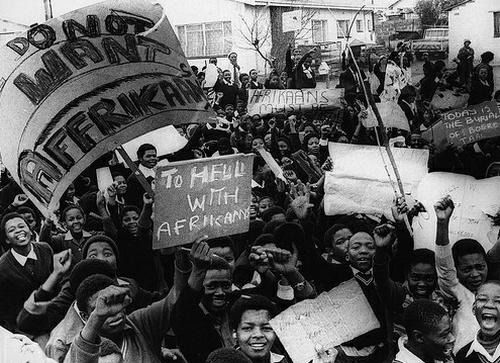 The 1976 uprisings against Afrikaans Image source
The 1976 uprisings against Afrikaans Image source
However, it is important to recognise that Afrikaans was also employed as a language of liberation during Apartheid (by White and Black/Coloured speakers alike). This article focuses on the Black history of Afrikaans in this regard. [5] The majority of Afrikaans speakers in South Africa are not White. [6] Fifty percent are Coloured people. [7] Indeed, there is a large body of work that focuses on the contribution of foreign slaves and indigenous Khoikhoi to the historical formation of Afrikaans: these population groups were subjugated by the colonists and discriminated against during Afrikaner nationalism and Apartheid, and yet their contribution to the language of their oppressors is documented and accepted. [8] Therefore, Afrikaans occupies a somewhat awkward place in South Africa’s linguistic historiography, it ‘is at once the language of the conqueror and the language of the oppressed’. [9]
Rather than focusing on the oppression of Black and Coloured people by White Afrikaans speakers, this article focuses on ways in which oppressed Afrikaans-speakers historically employed the language ‘to express [B]lack resistance’ in the eras of colonialism, Afrikaner nationalism and Apartheid. [10]
Afrikaans: A White/colonial or African language?
Afrikaans is the third most spoken language in South Africa. [11] Jansen argues that the language can be regarded as a unique ‘African-Germanic’ language: it did not originate within European borders and it ‘is spoken primarily in Africa’. [12] [13] [14] Afrikaans is also defined as a (southern) African creole language, spoken in South Africa, Namibia, Zimbabwe and Botswana. [15]
Due to its association with White Afrikaner nationalism and Apartheid, Afrikaans is popularly perceived as a ‘White’ language. [16] The Apartheid ideology ? according to André P. Brink (in Van den Heever) ? ‘colonise[d]’ the language. [17] Concurrently, Afrikaans is connected to racism, repression and violence. [18] It was, after all, the medium through which the Apartheid government (including police officers, ministers and civil servants) enforced ‘laws prohibiting contact between races in matters of housing, sexual relations, schooling and land ownership’. [19]
The 1976 Soweto protests against Afrikaans as a forced medium of instruction in Black schools were recognised globally. [20] The well-known photograph of murdered 13-year-old Hector Pieterson is one of many that reached global audiences and brought attention to the vitriol that Black people carried towards Afrikaans. [21] Photographs circulated of slogans on banners which read, for example, ‘We do not want Afrikaans’. [22] The ‘coercive power’ of the Apartheid government in forcing Afrikaans upon its populace led to ‘the uprising and especially in the wake of the state’s violent response, a hardened suspicion of its speakers’. [23] In addition, the ‘Black history’ of Afrikaans was denied by the hegemony of Afrikaner nationalism (including indoctrination ‘by Afrikaner Christian national education, propaganda and the media’). [24] Given this denial of the Black/Coloured history of the language, it is ironic that most Afrikaans speakers in South Africa are, as noted, not White.
White Afrikaans speakers only make up 40% of all South African Afrikaans speakers. [25] Coloured people, Black Africans and South African Indians constitute the other 60% of Afrikaans speakers. [26]
Extensive scholarly research substantiates the claim that people oppressed by colonialism, Afrikaner nationalism, and Apartheid significantly contributed to the formation of the language. [27] Neville Alexander, for example, asserts: ‘[i]f the Khoi[khoi], the San, and especially the slaves, were not forced to learn Dutch, or to speak it, then the language Afrikaans would not really have developed’. [28]
It is also argued that varieties of Afrikaans such as Cape Afrikaans are spoken by Coloured people and contributed greatly to the formation of the language. [29] Coloured people are the descendants of Europeans, the indigenous Khoikhoi, and imported slaves from countries such as Indonesia, Madagascar and Bengal. [30] It is claimed that three main groups contributed to the development of Afrikaans: the European settlers, the indigenous Khoikhoi and slaves from African and Asian countries [31]. Other groups who advanced language contact included Eastern political exiles (between 1652 and 1767, political prisoners were exiled to the Cape from countries such as Indonesia, India and Sri Lanka). [32] [33]
Afrikaans is therefore influenced by ‘Dutch; the seafarer variants of Malay, Portuguese and Indonesian; and the indigenous Kh[oikhoi] and San languages’. [34] Valley and Valley state: ‘while [A]frikaans’ [D]utch heritage cannot be denied, it must be acknowledged that it was shaped and molded away from [D]utch by the [K]hoi and [M]alay slaves.’ [35]
Vocabulary that demonstrates these influences, include, for example, the word baie/‘many’ (derived from the Malay word banyak) [36]; piesang/‘banana’ (Malay-derived); baadjie/‘jacket’ (Malay-derived); sambreel/‘umbrella’ (Portuguese-derived); mielie/‘mealie’ (Portuguese-derived); and gogga/‘bug’ (Khoikhoi-derived). [37] The expression baie dankie/‘many thanks’ is half-derived from Dutch (hartelijk dank) and Malay (banyak) respectively. [38]
In order to place these influences into context, a brief overview of the development of the language is provided in the following paragraphs.
Afrikaans developed in (local) colonial circumstances as a contact language: [39] The Cape was a ‘melting pot of languages’. [40] In 1595, Dutch traders and the indigenous Khoikhoi first came into contact at the Cape. [41] The local language Afrikaans thereby started to develop. [42] In 1652, the VOC established a refreshment station at the Cape. [43] Afrikaans originated within the creole community of the Cape Colony during the era of the [44].
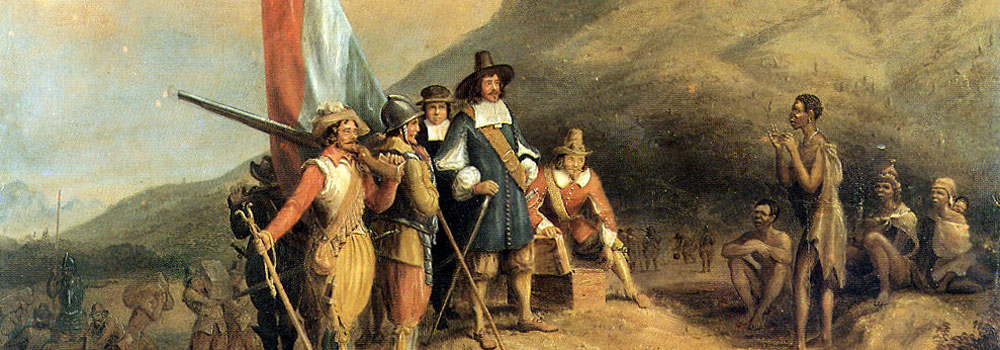 The indigenes encounter Jan van Riebeeck Image source
The indigenes encounter Jan van Riebeeck Image source
In colonial marketplace settings, the indigenous population is usually forced to attempt to converse in the invading settler’s language. [45] At the Cape, the local population had no choice but ‘to quickly adapt to the newcomers’ [Dutch East India Company officials] shrewd tactics when it came to negotiating and bartering’. [46] Interpreters, for example Krotoa, Autshomao and Doman, thereby became significant negotiators. [47] From 1658, the incoming slaves imported Malay and Portuguese (‘the lingua francas of trade in the Indian Ocean world in which the Dutch East India Company operated’) to the Cape. [48]
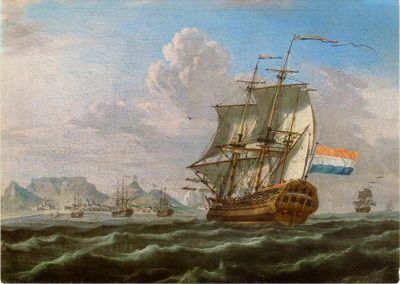 ‘Cape of Good Hope’ Image source
‘Cape of Good Hope’ Image source
At the early Cape during the Dutch East India Company era, documents of court cases recorded slaves’ spoken language: their recorded testimonies documented ‘some of the earliest examples of the restructuring of Dutch, which eventually resulted in the formation of Afrikaans’. [49] According to Jansen, ‘[t]his significant early shift from standard Dutch was first heard through the “voice of the slave”’. [50]
According to Shell, the first Afrikaans book was authored ‘by an imam, a slave descendant’. [51] Davids claims that ‘the first published Afrikaans work’ was the religious book Gablomatiem (1856), ‘written in Cape Dutch but in Arabic rather than Roman script’. [52] However, copies of this religious text did not survive. [53] Before the publication date of this text was discovered, it was thought that the first Afrikaans book was Zamenspraak tusschen Klaas Waarzegger en Jan Twyfelaar (L.H. Meurant, 1862) [54] (Giliomee cites this book as the first secular Afrikaans book). [55]
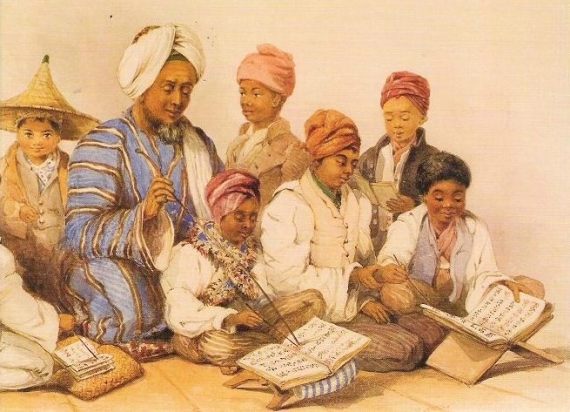 A representation of a madrassa, an Islamic religious school (‘The Afrikaans language is thought to have developed as a lingua franca for the slaves, as well as their masters, to be able to communicate effectively. Educated Muslims were in fact the first to write texts in Afrikaans’) Image source
A representation of a madrassa, an Islamic religious school (‘The Afrikaans language is thought to have developed as a lingua franca for the slaves, as well as their masters, to be able to communicate effectively. Educated Muslims were in fact the first to write texts in Afrikaans’) Image source
The Cape Dutch translation of Bayan al-Din (‘Exposition of the religion’), namely Uiteensetting van die godsdienst, was also written in Arabic script by Abu Bakr Effendi in Cape Town in approximately 1869. [56] Effendi ? a theologian born in Turkish Kurdistan ? was dispatched to the Cape in 1862 in his capacity as a religious advisor. [57] The British government requested his assistance as mediator regarding a disagreement between Cape Muslims. [58]
The publication of Uiteensetting van die godsdienst in 1877 in Constantinople (today Istanbul) was authorised by the Ottoman Empire’s Foreign Ministry to be distributed free of charge amongst Capetonian Muslims. [59] According to Jansen, ‘[t]he text is especially valuable for its adherence to the norms of Cape Dutch’. [60]
However, during the late nineteenth century, the creole language Afrikaans was appropriated by ‘patriotic male European colonists’. [61] These slave owners therefore ‘adopt[ed] [Afrikaans] … and call[ed] it their own’. [62] In this regard, Valley and Valley emphasise: ‘there is a side to the [A]frikaans language, the creole birth and [C]oloured connection that has been overlooked in our collective [S]outh [A]frican consciousness’. [63] Herewith a brief overview of the socio-political background of the White appropriation of Afrikaans, starting with the stigmatisation of the local, multi-racial Cape Dutch spoken language by the Dutch and English upper classes.
The local Cape Dutch dialect of the early to mid-nineteenth century differed from metropolitan/standard Dutch: ‘[a]t that stage Afrikaans was still definitely seen as an uncivilised patois spoken mainly by non-[W]hites’. [64] Dutch was utilised in the public spheres of the press, in schools and in churches. [65] White people as well as ‘people of colour’ spoke varieties of Afrikaans in the sphere of the home and in informal contexts. [66] The Dutch and English upper classes of the Cape Colony ridiculed Cape Dutch as, for example, Hotnotstaal [Hotnot language, an extremely derogatory label] and Kitchen-Dutch. [67] The multi-racial language Afrikaans was perceived as an embarrassment: by this time, distinctions based on race and class has become entrenched into society. [68]
Cape Dutch was ‘spoken by the peasants, the urban proletariat whatever their ethnic background and even the middle class of civil servants, traders and teachers’. [69] It was not considered by the upper classes as a language that ‘could express learning, writing or upper middle class culture’. [70] However, White, middle-class Cape Dutch speakers aimed ‘to disprove and counter such elite perceptions’. [71]
Furthermore, various nineteenth century political events ? such as the First Boer War ? contributed to ‘the struggle to give Afrikaans its rightful place’. [72] Afrikaner nationalism also arose during the 1870s as a response to the Anglicisation policy enforced over decades by British governors (such as lord Charles Somerset [73]) [74] [The first British occupation was between 1795 and 1803 [75], and the second from 1806 [76]]. This policy was enforced in the church, in schools and the civil service. [77]
The fight for Afrikaans coincided with the rise Afrikaner nationalism. [78] The Fellowship of True Afrikaners arose during the 1870s era of the rise of Afrikaner nationalism. [79] This Fellowship was established on 14 August 1875. [80] Their aim ‘was to convince Dutch and Afrikaans-speaking white people that Afrikaans could play an important role in their national consciousness and to regard themselves as a special community called Afrikaner’. [81] At the time, many Afrikaners perceived the language ‘as an incorrect form of Dutch’. [82] The group thereby endeavoured ‘to get Afrikaans recognised as a language distinct from Dutch’ and to develop a ‘high’ variety of Afrikaans. [83] The Fellowship published a newspaper to publicise their message. [84] The first edition was published on 15 January 1876: [85] Die Afrikaanse Patriot ‘was established to help convince the Afrikaners that Afrikaans is their own language. [86]
The Fellowship perceived Afrikaans as the language of the White Afrikaners. [87] The struggle for Afrikaans language rights excluded Coloured Afrikaans speakers. [88] [Valley and Valley note that these speakers are still being stigmatised: ‘it seems that the version of [A]frikaans spoken in the [C]oloured community is seen as a colloquial version of “pure” [A]frikaans and is almost always represented as being comical and never taken seriously’. [89]] Furthermore, the creole nature of Afrikaans was actively rejected; [90] written Dutch was utilised as the foundation for the standardisation of Afrikaans. [91]
In addition: the endeavour of language planners to separate ‘high’ Afrikaans from ‘low’ Afrikaans included the advocating of Afrikaans as ‘a formal written language with real cultural clout’. [92] However, ‘a standardised form of Afrikaans … became a marker of “[W]hiteness”; “Coloured Afrikaans” was considered quaint and sub-standard’. [93] It was thought that ‘high’ Afrikaans ‘as a written language … should have an image that was as ‘civilised’ (read: [W]hite) as possible’. [94] Valley and Valley confirm this point: ‘[A]frikaans, originally a language of the free slaves and the [K]hoi[khoi] inhabitants of the [C]ape, became a tool used by the oppressor’. [95] Standard Afrikaans is, according to social opinion, the ‘prestige’ Afrikaans variety; other varieties are viewed as inferior and lower in status. [96]
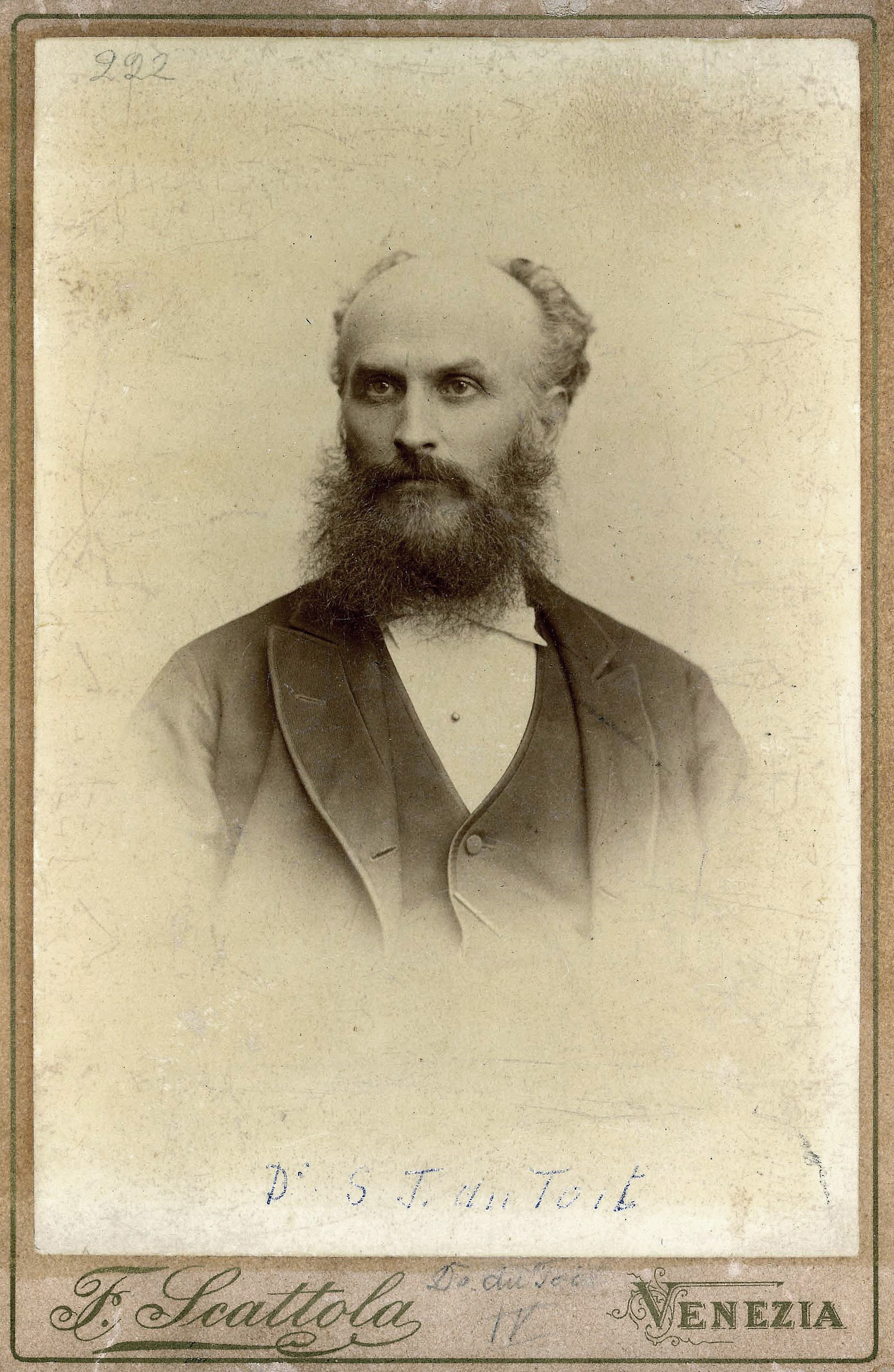 Stephanus Jacobus (S.J.) du Toit, leader of the Fellowship of True Afrikaners Image source
Stephanus Jacobus (S.J.) du Toit, leader of the Fellowship of True Afrikaners Image source
Willemse cites the consequences of Afrikaans constructed as a White language by, for example, Afrikaner language nationalists such as the Fellowship of True Afrikaners: [97]
In denying the commonality of their fellow Afrikaans speakers who were descendants of slaves, indigenous people or simply poor, they were elevating the language to a narrow ethnic nationalist cause. Through a web of actions and policies that influenced education, cultural and economic policies well into the 20th century, Afrikaans was constructed as a ‘[W]hite language’, with a ‘[W]hite history’ and ‘[W]hite faces’ [as previously stated]. [98]
However, several authors argue that the language does not exclusively signify suppression and racism. For example, Jansen states that ‘Afrikaans is not merely the language of [W]hite Afrikaner nationalism … Afrikaans predates and extends beyond [A]partheid’. [99] Similarly, Titus asserts that ‘Afrikaans does not equate Afrikaner’. [100] Willemse emphasises the language as one of resistance:
While our recent sociopolitical history often casts Afrikaans as the language of racists, oppressors and unreconstructed nationalists, the language also bears the imprint of a fierce tradition of anti-imperialism, anti-colonialism, of an all-embracing humanism and antiapartheid activism. [101]
Similarly, Cecyl Esau [Memories of a political prisoner on Robben Island, 1987-1991] reminisces that many Coloured people ‘fought just as hard [as the 16 June 1976 protestors] in the struggle against apartheid … in Afrikaans’. [102] However, Van den Heever emphasises the ambivalence experienced by Coloured Afrikaans speakers, namely, ‘the conflict between his Afrikaans mother-tongue and his vision of liberation from Afrikaner-dominance [which] unleashed an intense ambivalence in the mind of the oppressed Afrikaans-speaker’. [103]
Similarly, Sonn highlights this ambiguity faced by Coloured Afrikaans speakers (on the back cover of a book which focuses on the role of Coloured Afrikaans speakers in the development of Afrikaans): they speak the language and were oppressed in the language. [104] To elaborate: Sonn notes ‘the ambivalence about the Afrikaans of our heart and the distasteful way in which we were oppressed and disregarded’ in this language. [105] However, he also affirms that ‘Afrikaans is not only the language of [A]partheid; Afrikaans is also the language of the struggle and reconciliation’. [106]
The next section of this article focuses on Afrikaans utilised as a language to express resistance by slaves and Coloured people during the historical eras of colonialism, Afrikaner nationalism, Apartheid, and the post-Apartheid era.
Resisting colonialism: the ghoemaliedjies [ghoema songs] and the Genadendal printing press
The earliest forms of resistance to colonial linguistic influence include ghoema songs (that form part of Cape Muslim slave culture) and texts (originating from the printing press of the first South African mission station, Genadendal).
Firstly, the ghoemaliedjies of the Cape Muslim slave culture are explored. As stated previously, slaves and Eastern political exiles arrived in 1658, and between 1652 and 1767 respectively. Indonesian prisoners transferred their literary traditions such as the pantun to the Cape and [107] the ghoemaliedjie shares likenesses with this form of song. [108] Even though ghoemaliedjies are tricky to date [109], they ‘include references that could, arguably, be used to claim that during the period of the Dutch East India Company rule slaves created adaptations of both … the pantun, and the Dutch popular song, the mopje’. [110]
Ghoemaliedjies formed a significant part of slave culture. [111] They are a mélange of Dutch and Indonesian folksongs. [112] Historically, ghoemaliedjies were sung in Malay-Portuguese, Malay-Dutch, Afrikaans and English. [113] Furthermore, numerous early Dutch folksongs ‘developed into Afrikaans (sometimes in a dialect which reveals their Dutch origins)’. [114] Ghoemaliedjies also appropriated the forms of Dutch folk songs. [115]
In general, ghoemaliedjies are overtly satirical: they were used by slaves to comment on the colonists. [116] A specific form of this song utilises the form, rhythm and lyrics of traditional Dutch (and subsequently Afrikaans) folksongs. [117] Winberg notes the significance of language use in these songs:
The adaptation of the colonists’ language by slaves was not an act of submission. They took the [W]hite man’s language, altered it, added new words and, very often, threw it back in parody … Song, as Vernon February has pointed out, was one of the few means by which [W]hite society could be satirised (February 31). Adaptation of the oppressor’s language and culture is a feature of many slave societies. [118]
The Dutch colonists’ songs were subtly altered by their servants for commentary on their masters. [119] The ghoemalied is mainly influenced by a specific form of Dutch folk song, the ‘pieknieklied’ (picnic song). [120] In this regard, the ghoemalied ridicules respected elderly figures within the conservative Dutch community: many ooms [uncles] and tannies [aunties], such as ‘oom [uncle] Jannie’, were mocked as so-called picnic personae. [121]
The appropriated ghoemalied also mocks the ‘sentimentalised boerenooi [farm girl]’ (‘The idealised farm girl is the heroine of a multitude of romantic folksongs’). [122] In addition to the boerenooi, the slaves mocked their White madams [123]/the boerevrou [boer woman]. [124]
Slaves sung ghoemaliedjies on their annual picnics (which slave owners were required to provide). [125] Therefore, the ghoemaliedjie is (also) referred to as, for example, a ‘Malay picnic song’ or a ‘moppie’. [126] At present, Ghoemaliedjies are still performed at the annual Malay Choir Competition. [127] Traditionally, these songs form an important part of the Cape Minstrel Carnival. [128]
Winberg finds the appropriation of Malay songs by Afrikaners ‘as expressions of a folk consciousness’ ironic: [129] ‘[t]he satirical traditions of the ghoemaliedjie live on … in the most soulful utterances of Afrikanerdom’. [130] The (perceived) Afrikaner folk songs, for example, Siembamba and Suikerbossie, were created within the Muslim community (Du Plessis: 1935:113, 134). [131] Therefore, ‘[s]ongs which originated in the Dutch community were sung as parodies by Muslims and then re-emerged as Afrikaner folk songs’. [132]
|
|
Other texts that oppose colonialism include a monthly journal (De Bode van Genadendal, 1859) and a novella (Benigna van Groenekloof of Mamre, 1973), both printed at the printing press in Genadendal (initially called Baviaanskloof [133]). Genadendal is the oldest mission station in South Africa, [134] established in 1738 [135] by the missionary Georg Schmidt. [136] His ‘main task was to teach the Khoikhoi the Christian doctrine’. [137]
In this Moravian mission town, Afrikaans is ‘the mother-tongue’. [138] Titus notes the role the Genadendal printing press played in resisting colonial linguistic influence: ‘[o]ther than the Fellowship for True Afrikaners in 1875, Genadendal Dutch had already in 1816 cut itself off from the High Dutch and is also printed on a Gutenberg-model-printing press.’ [139] Titus also emphasises the contribution of Genadendal to the Afrikaans language: ‘[it] played a large role in the establishment of the spoken language to a written language … on the other hand because it had one of the first printing presses in the Cape where this language could be promoted and published in letter and book form’.> [140]
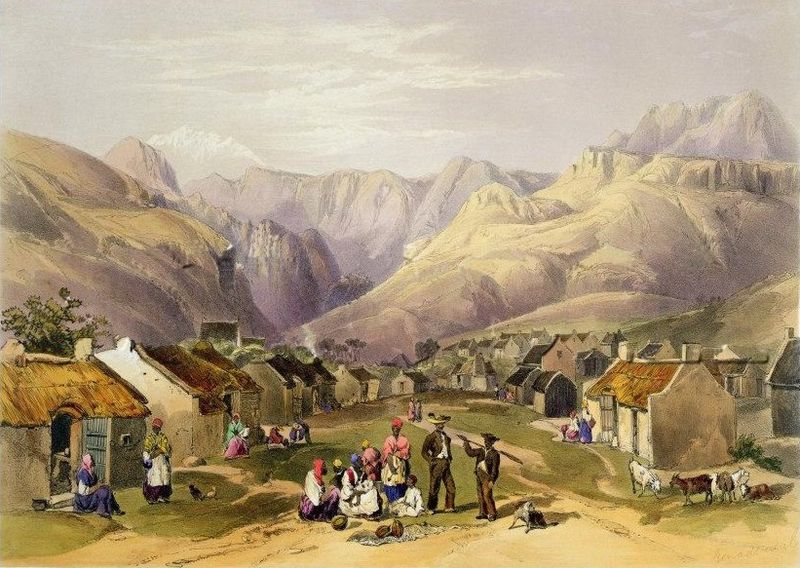 Genadendal Mission Station (c. 1849) Image source
Genadendal Mission Station (c. 1849) Image source
The first Genadendal text is De Bode van Genadendal, a monthly journal established in 1859 (since 1914, published as Die Huisvriend). [141] Taking the date of the Bode’s publication into account, it is argued that Die Afrikaanse Patriot (1876) is not the first Afrikaans newspaper: the latter view is perpetuated in ‘Afrikaner-centric … traditional language history textbooks’. [142] It is thereby significant to note that the White Afrikaans speakers of the Fellowship for True Afrikaners were not amongst the first Afrikaans speakers to help to establish Afrikaans in written form.
White people initiated and were the first editors and writers for De Bode; however, it ‘quickly became the mouthpiece of [C]oloured Afrikaans talent’. [143] The White (and subsequently Coloured) editors requested members of the congregation to submit contributions such as articles, stories and poems. [144] Other contributions also included letters. [145] These contributions, comprising hundreds of pages, are considered very significant Afrikaans literary pieces. [146]
This printing press also published a novella about a Coloured woman, Benigna van Groenekloof of Mamre [147] (published anonymously in 1873) [148] The book by C.P. Hoogenhout is therefore not, as perceived, the first Afrikaans novel, published in the same year). [149] [Kannemeyer cites this book, titled Die geskiedenis van Josef, as the first ‘extensive [Afrikaans] work of prose’. [150]]
The novella Benigna aimed to address the needs of Christian Coloureds and to permit the people to tell their own real-life stories and stories from their history in their own language (oral sources provided much of the material). [151] The novella is informed by political ideology: it comments on problematic human relationships in terms of racial discrimination (Benigna, a Coloured girl, is forbidden to attend school with her White friend; their friendship is thereby threatened). [152]
Letters published in De Bode are also regarded as significant anti-colonial Afrikaans texts. Between 1899 and 1914, former students corresponded in the form of letters. [153] These letters were deliberately written in this era’s common spoken language: the writers expressed that if something is written in the way one speaks, one can understand better. [154] As previously stated, Afrikaans ? in contrast to standard Dutch ? was perceived as ‘plattaal’ [literal translation: flat language] at the time. [155]
However, in these letters, it was encouraged that readers would want to read something ‘in their language’: ‘[i]t is indeed true, that a lot of people say that what the people speak here at the Cape is not a language. [156] I do not agree with this. Even though the language does not have grammar, the people indeed express their thoughts with the language and indeed in words’ (De Bode 1904:68). [157] Another letter deliberates: how would school inspectors ? being amongst those who ‘fight so hard for the Dutch language’ ? react if learners do not write in standard Dutch (De Bode 1899:76). [158] Taking the above discussion into account, resistance against the colonists’ language (standard Dutch) is expressed.
In the next section, texts that oppose Afrikaner nationalism are emphasised. As noted, Afrikaner nationalism arose during the 1870s. In the early twentieth century (from 1900 to 1930), Afrikaner nationalism became a more serious and purposeful national movement; it became much bigger than the endeavours of the Fellowship of True Afrikaners. [159] Furthermore, the South African War ‘was the spark needed to fight for Afrikaans’. [160]
Within the first three decades of the twentieth century, various Afrikaner language organisations, publications (such as newspapers) and publishing houses were established. [161] In 1918, Afrikaans was introduced as a university subject. [162] In the same year, the Afrikaner-Broederbond was established ‘with the aim of helping to build the Afrikaner in cultural and economic terms’. [163]
By 1925, Afrikaans was established as a medium of instruction (for Afrikaans speaking learners) in schools. [164] In 1925, Afrikaans was ? alongside English ? ‘fully recognised as a language of South Africa’. [165] The following year, a comprehensive Afrikaans dictionary was established. [166] In 1933, the Bible was translated into Afrikaans. [167] In the next section, texts that oppose Afrikaner nationalist hegemony – including firstly, the satirical column Straatpraatjes, and secondly, poetry – are discussed.
Resisting Afrikaner nationalism: Straatpraatjes and the first Black Afrikaans poet
The satirical column Straatpraatjies was published between 1909 and 1922 in the newspaper of the APO [168] [the African Political Organisation]. The APO ? established in 1902 in Cape Town ? is cited as ‘the first substantive Coloured political pressure group in the Cape Colony’. [169] The first issue of the APO’s newspaper, titled APO, was published on 24 May 1909. [170] The APO criticised ‘the [W]hite commercial press’ of, amongst others, assuming ‘that South Africa belongs to the [W]hites … by right of conquest’. [171] The leader of the APO, Abdullah Abdurahman, is suspected to be the writer of Straatpraatjes (which was written under the pseudonym Piet Uithalder) [172].
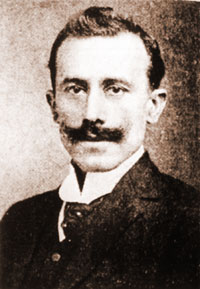 Abdullah Abdurahman Image source
Abdullah Abdurahman Image source
Straatpraatjes is based on the (White middle-class) Afrikaans column Parlementse Praatjes (published in the newspaper De Zuid-Afrikaan, ‘the leading Dutch newspaper in the Cape’). [173] For the APO, this column represented Afrikaner – therefore not Coloured – interests. [174] The Straatpraatjes column thereby endeavoured ‘to express [C]oloured interests in the language of the [C]oloured community’. [175] It is cited as ‘the earliest example that we know of where Afrikaans is used to articulate [B]lack resistance to [W]hite domination’. [176] Satire was utilised as a ‘weapon … against [Abdullah Abdurahman’s] Afrikaner nationalist opponents. [177]
The column rejected, for example, segregation, White racism, and ‘mocked the operations of Parliament’. [178] Furthermore, ‘to address readers in the unique language of his community’ (namely, ‘the Afrikaans vernacular that is spoken in the urban [C]oloured community of the Western Cape’), was a ‘novelty’. [179] This conscious utilisation of ‘the vernacular of the [C]oloured working class of Cape Town’ thereby contrasted with the form of Afrikaans used by White middle-class speakers in, for example, the Parliament. [180]
Approximately two decades after Straatpraatjes ended, the first Black Afrikaans poet published his first collection of poems. S.V. Petersen is regarded as the first Black Afrikaans poet. [181] His debut collection of poems, titled Die enkeling, was published in 1944. [182] Willemse cites Petersen as ‘the first [C]oloured writer to debut in Afrikaans’. [183] His poetry overtly confronts the social environment: [184] his social position did not grant him access to ‘mainstream Afrikaans cultural life’. [185]
In 1948, the National Party came to power. [186] Between 1948 and 1953, most Apartheid laws were adopted. [187] During the 1940s, ‘Afrikaans became perceived as the language of the oppressor and a symbol of apartheid’. [188] Afrikaans became more powerful: ‘[b]y the time that the nationalists came to political power in 1948 Afrikaans’ position was further bolstered and it gained a foothold in all sectors of society, including the civil service and the economy’. [189]
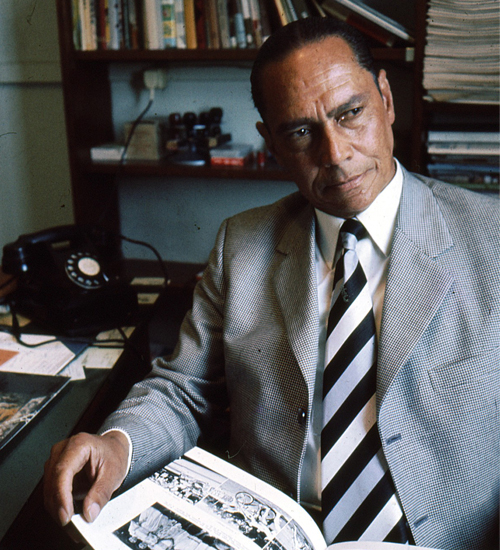 S.V. Petersen Image source
S.V. Petersen Image source
However, it is during the era of the Apartheid liberation struggle that people simultaneously resisted against Afrikaans and resisted in Afrikaans. Valley and Valley state:
[W]hile [B]lack students in Soweto were protesting against the use of Afrikaans as the language of instruction, Afrikaans-speaking [C]oloured youth joined in the fight against the government, and used their Afrikaans to mobilise communities to fight against the injustices of the day. Members of the UDF, Ashley Kriel, Allan Boesak and Cheryl Carolus come to mind as some of the youth who were at the forefront of resistance politics in Cape Town in the 1970s and ’80s. [190]
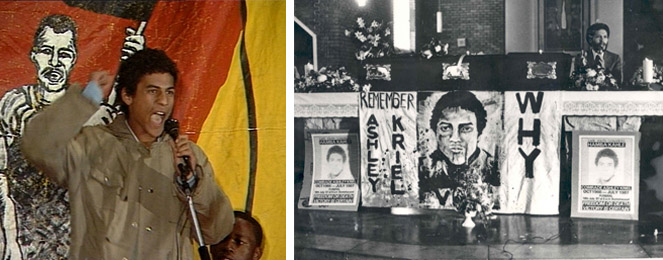 Ashley Kriel Image source
Ashley Kriel Image source
The next section explores Afrikaans utilised as a language of resistance during the Apartheid liberation struggle by writers, academics, educators and student activists.
Afrikaans and the liberation struggle, in Afrikaans
The following sections focus on anti-Apartheid poetry collections, conferences, movements, protests, theatre and hip-hop during the 1960s, 1970s and 1980s. Willemse cites an alternative history of Afrikaans as ‘the history of resistance’: [191]
It was a decision rooted in the uprisings in which Afrikaans was labelled ‘the language of the oppressor’. The slogan was rightly an emotive, visceral response to Afrikaner ethnic, nationalist hegemony and its concomitant coercive state power, but it also obscured the experiences, lives and histories of [B]lack and non-nationalist Afrikaans speakers. [192]
A significant component of resistance in Afrikaans against the hegemonic system included literature such as protest poetry and the activism of writers.
Protest poetry
In 1961, Adam Small published one of his most famous poetry collections, Kitaar my Kruis. [193] It was protest poetry written in Kaaps/Cape Afrikaans: ‘Small launched a cutting attack on South African society…’ [194] Jakes Gerwel also cites Hein Willemse, for example, as political struggle poet. [195] His debut poetry collection, Angsland (1981), is ‘the only South African-published [work] that was not published at any of the establishment Afrikaans publishers’ [196] (Gerwel cites this choice as a political statement). [197]
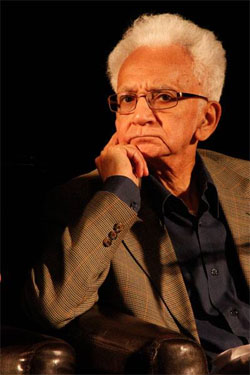 Adam Small Image source
Adam Small Image source
During the 1980s, writers and scholars also expressed anti-Apartheid sentiments at conferences.
1980s writers’ conferences
The Victoria Falls conference in Zimbabwe took place in July 1989, attended by predominantly [White and Coloured] Afrikaans writers [198] such as Breyten Breytenbach, André P. Brink, Antjie Krog, Vernie February, Hein Willemse, Julian Smith, and Patrick Petersen. [199] According to Coetzee, Afrikaans writers began to resist ‘the cultural hegemony on which the ruling class built its political regime … [A]partheid and National Party authoritarianism’ in the 1960s. [200] However:
…as the ANC had been banned and demonised by the ideological state apparatus since the sixties these progressive voices were left without a means of discourse. For the writers of that decade and their literary descendants to meet writers in exile and ANC political workers became an opportunity for them to be more actively involved in a solution for South Africa – to realise that this country can have a future away from [A]partheid and violence. [201]
At this conference, Patrick Petersen contributed in Afrikaans, speaking about the politicisation of Black Afrikaans poetry. He asserted that his ‘political involvement … as word artist [is] unavoidable’. [202] Petersen emphasises the importance of poetry in the struggle: [203] ‘[p]oetry … has to break the silence … break through barriers … go to the podium and give the [B]lack power sign. [204] Poetry resisting the struggle ‘offsets the policy of disguise and distortion of reality that is followed in the official culture … The [B]lack writer is therefore called to evoke the liberation struggle with his own people’. [205]
Petersen highlights another role of Black Afrikaans poetry: it ‘challenges the traditional notions about what literature is and what should be made part of the canon’. [206] Furthermore, he highlights structural problems within society, such as poverty, censorship, ‘colonialism, violence, humiliation and oppression and also the struggle against it’ as impediments to the development of Black Afrikaans literature. [207]
In April 1985, a symposium for Black Afrikaans writers was held at the University of the Western Cape. According to the editors of the conference report, one of the conference’s objectives was to focus on literary activity other than literature canonised by the Afrikaans establishment. [208] Academics such as Jakes Gerwel, Julian Smith, Patrick Petersen, Peter Snyders, and Hein Willemse were participants. [209] Willemse emphasises that, at the time, ‘young Black Consciousness inspired academics’ such as himself, ‘understood that a different story needed to be told. [210] At the very least, one that tells of a more encompassing history, a history that explored the life and culture of those marginalised, i.e. the neglected histories, language, literature and culture of Black Afrikaans speakers’. [211]
A historical movement that focused on marginalised Afrikaans speakers in the sphere of education, is the Alternative Afrikaans Movement.
The Alternative Afrikaans Movement
During the 1980s, Cape Afrikaans teachers protested against the exclusive focus on and favouring of standard Afrikaans/‘White’ Afrikaans in education. [212] They underscored, for example, the struggles of Cape Afrikaans speaking learners regarding standard Afrikaans as a medium of instruction. [213] Educators aired their grievances via their education union, the Kaaplandse Professionele Onderwysersunie (KPO). [214] During a February 1988 congress of the KPO, the idea of so-called alternative Afrikaans regarding the subject Afrikaans, was discussed. [215] The predominant definition of alternative Afrikaans includes the idea that ‘the school subject Afrikaans has to be purified from racial judgements and … prejudices, and from its [W]hite favouring. The conversations … emphasise that Afrikaans belongs to all its speakers. It is not so that one subgroup can claim the language’. [216]
Van den Heever underscores the importance of the notion of alternative Afrikaans: it ‘is of utmost importance in the democratic movement because the conflict between his Afrikaans mother-tongue and his vision of liberation from Afrikaner-dominance unleashed an intense ambivalence in the mind of the oppressed Afrikaans-speaker’. [217]
In addition to teachers, community leaders, students and learners also resisted White Afrikaner hegemony in Afrikaans.
Student political mobilisation and activism
Coloured people fought Apartheid oppression also in Afrikaans. [218] Van den Heever notes prominent Afrikaans community leaders, for example, Allan Boesak, Jakes Gerwel and Franklin Sonn. [219] They fought oppression in the liberation struggle in various spheres: the church, the university and education respectively. [220] Coloured learners in the Cape and students at the University of Western Cape [UWC] also fought Apartheid in Afrikaans. [221]
Willemse relates how the University of the Western Cape [UWC] of 1976 was central to student activism:
[UWC] became the hub of the student uprising in the Western Cape and we as students sang revolutionary songs in isiXhosa, English and in Afrikaans … We performed plays and poetry in Afrikaans and a young, eloquent firebrand named Allan Boesak whipped us all into rousing Black Consciousness fervour - in Afrikaans … This is an example of Afrikaans in resistance; it is also an example of a counternarrative unknown to those outside the sphere of Afrikaans speakers. [222]
MacMaster cites the leading role of UWC in the 1976 Cape Peninsula revolt: colleges, schools and communities were inspired by the student protest. [223] They ‘began revolting in solidarity with Soweto, in the fight against [A]partheid and in support of the liberation struggle’. [224] MacMaster reminisces about a song from the Cape Flats: ‘Oubaas Vorster, Oubaas Vorster/ Slaap jy nog, slaap jy nog?/ Hoor hoe skreeu die kinders/ Hoor hoe skreeu die kinders:/ Equal rights, equal rights!’ [Old man Vorster, Old man Vorster/ Are you still sleeping, are you still sleeping?/ Hear how the children shout/ Hear how the children shout:/ Equal rights, equal rights!’] [225]
Basil Kivedo, a former MK-soldier, asserts: ‘…I was arrested by the security police in Afrikaans, I was detained in Afrikaans, I was tortured in Afrikaans, but I fought back in Afrikaans’. [226] Kivedo also emphasises his involvement in student leader politics. [227] He ‘targeted certain students as possible recruits for the liberation struggle’ in, for example, Bonteheuwel, Hanover Park, Lavender Hill and Manenberg. [228] He underscores his ‘close ties with radical members of the Bonteheuwel Military Wing (BMW)’ [229], including Ashley Kriel, Anton Fransch and Colleen Williams (Kivedo and the commander of the BMW initiated political education sessions with members). [230] According to Kivedo: ‘[t]he medium of instruction in all cases Afrikaans’ (given that it was in Bonteheuwel). [231]
Kivedo also underscores his acquaintance with student leaders such as Cheryl Carolus, stating that numerous student leaders fought in Afrikaans. [232] At the 33rd anniversary of the UDF, Cheryl Carolus asserted: ‘[w]e spoke everyone’s language at public meetings’ (including Afrikaans, English and Xhosa when meeting in Bonteheuwel). [233]
Community activism also included Black community theatre and the hip-hop movement on the Cape Peninsula.
Theatre and hip-hop
During Apartheid, Black community theatre thrived in the predominantly Afrikaans-speaking northern suburbs of the Cape Peninsula (including, for example, Belhar, Elsiesrivier, Ravensmead, Bellville, Kuilsrivier and Kraaifontein). [234] Categories such as social-political dramas were performed predominantly in Kaaps/Cape Afrikaans (‘the language of the [Cape] Flats’). [235] These dramas include, for example, Melvin Whitebooi’s Dit sallie blerrie dag wies. [236] Fransman emphasises the significance of the socio-political dramas of the drama-group, the Cape Flats Players [established in 1973 by Adam Small [237]]. [238] They performed dramas such as Kanna hy kó hystoe (Adam Small, 1965) and Joanie Galant-hulle (also by Adam Small, 1978). [239] These dramas ‘tackled the issues of their own communities’ [240] (such as racism and the Group Areas Act). [241]
Hip-hop in Cape Town emerged during the 1980s, including the group Prophets of da City. [242] They were part of the ‘Old Skool [School]’, ‘a group of young MCs with a political conscience, coming mostly from [C]oloured townships, and addressing current issues in the language of the street’. [243] During this era, hip-hop was banned on radio, thereby remaining underground. [244] The establishment regarded hip-hop as ‘subversive’ and repressed it. [245] Watkins asserts that ‘Hip-hop in Cape Town emerged mainly as a platform for articulating resistance to the [A]partheid regime’. [246] Haupt terms ‘indigenised’/localised hip-hop as the ‘use of local dialects and idiomatic expressions’ that focuses on ‘very local concerns’. [247] Battersby also notes the use of the vernacular in hip-hop:
The standardisation of Afrikaans by [W]hites played a decisive role in the discourse of power during [A]partheid, through its exclusion of the variants of Afrikaans spoken by [B]lack/Coloured speakers. The use of the vernacular subverts the impacts of colonialism [and] creates a unifying force among the colonised and a site of intercultural conflict. Invariably in South African hip-hop the vernacular is used in such a manner as to challenge the logic presented by power structures’. [248]
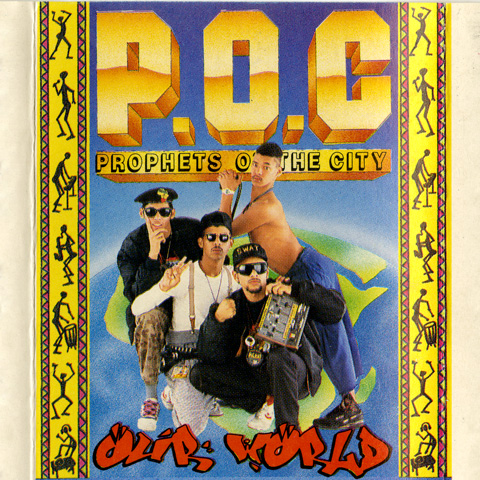 Two decades before Die Antwoord, Prophets of Da City released South Africa’s first hip-hop album (including one of the first Afrikaans rap tracks, titled Dallah Flét) Image source
Two decades before Die Antwoord, Prophets of Da City released South Africa’s first hip-hop album (including one of the first Afrikaans rap tracks, titled Dallah Flét) Image source
Resistance against colonialism and Afrikaner nationalist hegemony did not end with Apartheid. In the next section, a local and international protest theatre production, titled Afrikaaps, is discussed.
Post-apartheid resistance: Afrikaaps
A contemporary theatre production that combines hip-hop with Cape Afrikaans, is titled Afrikaaps. Afrikaaps is a protest theatre production that has performed mainly in Cape Town and the Netherlands between 2010 and 2015. [249] The 2010 documentary film with the same title, directed by Dylan Valley, chronicles the 2010 performances of the production. Afrikaaps ? directed by Catherine Henegan with Aryan Kaganof offering creative input ? comprise eight mainly Coloured hip-hop artists and social activists from the Cape Flats: Emile Jansen (Emile YX? Jansen); Jethro Louw; Janine van Rooy-Overmeyer (Blaq Pearl); Quintin Goliath (Jitsvinger); Moenier Adams (Monox); Charl van der Westhuizen (Bliksemstraal); Shane Cooper and Kyle Shepherd. [250] In addition to clips from the Afrikaaps documentary and dialogues, the production uses hip-hop, soul, jazz, r&b, reggae, and performance poetry/spoken word. [251]
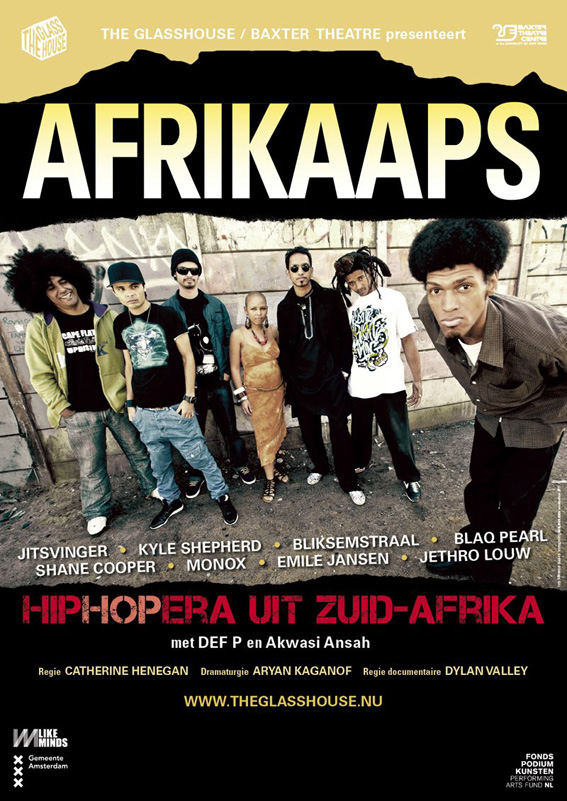 Poster advertising the 2011 Afrikaaps Dutch tour Image source
Poster advertising the 2011 Afrikaaps Dutch tour Image source
The production advocates Afrikaans as an indigenous, creole language. Afrikaaps thereby affirms that the language was formed at the early, cosmopolitan Cape (also) by the ancestors of Coloured people (namely the indigenous Khoikhoi and Malay slaves). [252] Afrikaaps thereby aims to refute the claim that Afrikaans is a colonial language of the White Afrikaner oppressor. [253] The White appropriation of Afrikaans during Afrikaner nationalism and Apartheid is especially highlighted.< [254] Furthermore, the production highlights issues surrounding marginalised and stigmatised Cape Afrikaans as a response and resistance to the racialised hegemony of standard/‘pure’ Afrikaans of the White Afrikaner oppressor. [255] Indigenous (Khoikhoi and San) and slave (‘Malay’) cultural heritage, and Cape Afrikaans as a mother-tongue, is celebrated. [256]
*[Insert (video 16)]
Conclusion
This essay aimed to demonstrate the various ways in which Black/Coloured Afrikaans-speakers have resisted oppression in numerous forms throughout various eras in South African history: colonialism, Afrikaner nationalism, and Apartheid. Since the era of colonialism, songs, newspapers, writers, academics, educators, students, theatre practitioners and hip-hop artists have all challenged repression, in Afrikaans.
Endnotes
[1] Ena Jansen, "Afrikaans: A Language on the Move," in Good Hope: South Africa and the Netherlands from 1600, ed. Martine Gosselink, Maria Holtrop and Robert Ross (Rijksmuseum, Vantilt Publishers, 2017), 337. ↵
[2] Jansen, Afrikaans: A Language on the Move, 337. ↵
[3] “#FeesMustFall protest reminiscent of 1976 uprising,” enca.com, date posted October 24, 2015, http://www2.epa.gov/laws-regulations. ↵
[4] Menán van Heerden, "Afrikaaps: A Celebratory Protest Against the Racialised Hegemony of ‘Pure’ Afrikaans" (Master’s thesis, Stellenbosch University, 2016). http://hdl.handle.net/10019.1/100364. ↵
[5] “The hidden histories of Afrikaans,” up.ac.za, date posted February 22, 2016, http://www.up.ac.za/en/faculty-of-humanities/news/post_2235567-the-hidden-histories-of-afrikaans. ↵
[6] Jansen, Afrikaans: A Language on the Move, 337. ↵
[7] Danny Titus, "Afrikaanse boek van bruin kant ? Taal en identiteit op die Afrikaanse werf," in Ons kom van vêr: Bydraes oor bruin Afrikaanssprekendes se rol in die ontwikkeling van Afrikaans, red. W.A.M. Carstens en Michael le Cordeur (Tygervallei: Naledi, 2016), 188. ↵
[8] Menán van Heerden, "Afrikaaps: A Celebratory Protest Against the Racialised Hegemony of ‘Pure’ Afrikaans" (Master’s thesis, Stellenbosch University, 2016). http://hdl.handle.net/10019.1/100364. ↵
[9] “Postcolonialism and Afrikaans literature,” postcolonialweb.org, accessed March 6, 2017, http://www.postcolonialweb.org/sa/viljoen/1.html. ↵
[10] Herman Wasserman, and Sean Jacobs, eds. Shifting selves: Post-apartheid essays on mass media, culture, and identity (Cape Town: Kwela, 2003), 267 ↵
[11] Jansen, Afrikaans: A Language on the Move, 337. ↵
[12] Ibid. ↵
[13] Ibid. ↵
[14] Ibid., 337-338. ↵
[15] “The hidden histories of Afrikaans,” up.ac.za, date posted February 22, 2016, http://www.up.ac.za/en/faculty-of-humanities/news/post_2235567-the-hidden-histories-of-afrikaans. ↵
[16] Jansen, Afrikaans: A Language on the Move, 337. ↵
[17] André P. Brink, "Afrikaans en oorlewing," in Skrywer en gemeenskap: tien jaar Afrikaanse skrywersgilde, red. Charles Malan en Bartho Smit (Pretoria: HAUM, 1985), 167. ↵
[18] Jansen, Afrikaans: A Language on the Move, 337. ↵
[19] Ibid. ↵
[20] Ibid. ↵
[21] Ibid. ↵
[22] Ibid. ↵
[23] “The hidden histories of Afrikaans,” up.ac.za, date posted February 22, 2016, http://www.up.ac.za/en/faculty-of-humanities/news/post_2235567-the-hidden-histories-of-afrikaans. ↵
[24] Ibid. ↵
[25] Jansen, Afrikaans: A Language on the Move, 337. ↵
[26] Ibid. ↵
[27] Menán van Heerden, "Afrikaaps: A Celebratory Protest Against the Racialised Hegemony of ‘Pure’ Afrikaans" (Master’s thesis, Stellenbosch University, 2016). http://hdl.handle.net/10019.1/100364. ↵
[28] Menán van Heerden, "Afrikaaps: A Celebratory Protest Against the Racialised Hegemony of ‘Pure’ Afrikaans" (Master’s thesis, Stellenbosch University, 2016). http://hdl.handle.net/10019.1/100364. ↵
[29] Jansen, Afrikaans: A Language on the Move, 337. ↵
[30] Ibid. ↵
[31] Paul T. Roberge, "Afrikaans: Considering Origins," in Language in South Africa, ed. Rajend Mesthrie (Cambridge: Cambridge University Press, 2002), 79. ↵
[32] Paul T. Roberge, "Afrikaans and Creolisation," in Afrikaans. Een drieluik, eds. Frans Hinskens, Jerzy Koch and Hans den Besten (Amsterdam: Stichting Neerlandistiek VU, 2009), 213. ↵
[33] Christine Winberg, “Satire, slavery and the ghoemaliedjies of the Cape Muslims,” New Contrast 19 (1992):78. ↵
[34] “The hidden histories of Afrikaans,” up.ac.za, date posted February 22, 2016, http://www.up.ac.za/en/faculty-of-humanities/news/post_2235567-the-hidden-histories-of-afrikaans. ↵
[35] Valley, Greer, and Dylan Valley. “Hip Hop Masala.” Kaganof.com. Date posted: May 22, 2009. http://kaganof.com/kagablog/?s=hip+hop+masala. ↵
[36] Jansen, Afrikaans: A Language on the Move, 338. ↵
[37] Ibid., 341. ↵
[38] Ibid., 338. ↵
[39] Jansen, Afrikaans: A Language on the Move, 337. ↵
[40] Ibid. ↵
[41] Ibid. ↵
[42] Ibid. ↵
[43] J.C. Kannemeyer, Geskiedenis van die Afrikaanse literatuur I (Kaapstad: Academica, 1978), 9. ↵
[44] Roberge, Afrikaans and Creolisation, 209. ↵
[45] Jansen, Afrikaans: A Language on the Move, 337. ↵
[46] Ibid. ↵
[47] Ibid. ↵
[48] Ibid. ↵
[49] Jansen, Afrikaans: A Language on the Move, 338. ↵
[50] Ibid. ↵
[51] Robert Carl-Heinz Shell, Children of Bondage: A Social History of the Slave Society at the Cape of Good Hope (Hanover: University Press of New England, 1994), 64. ↵
[52] Jansen, Afrikaans: A Language on the Move, 340. ↵
[53] Ibid. ↵
[54] Ibid. ↵
[55] Hermann Giliomee, Die Afrikaners: ’n Biografie (Kaapstad: Tafelberg, 2004), 176. ↵
[56] Jansen, Afrikaans: A Language on the Move, 340. ↵
[57] Ibid. ↵
[58] Ibid. ↵
[59] Ibid. ↵
[60] Ibid. ↵
[61] Shell, Children of Bondage, 64. ↵
[62] Ibid. ↵
[63] Valley, Greer, and Dylan Valley. “Hip Hop Masala.” Kaganof.com. Date posted: May 22, 2009. http://kaganof.com/kagablog/?s=hip+hop+masala. ↵
[64] Jansen, Afrikaans: A Language on the Move, 339. ↵
[65] Ibid., 340. ↵
[66] Ibid. ↵
[67] “The hidden histories of Afrikaans,” up.ac.za, date posted February 22, 2016, http://www.up.ac.za/en/faculty-of-humanities/news/post_2235567-the-hidden-histories-of-afrikaans. ↵
[68] Giliomee, Die Afrikaners, 176. ↵
[69] “The hidden histories of Afrikaans,” up.ac.za, date posted February 22, 2016, http://www.up.ac.za/en/faculty-of-humanities/news/post_2235567-the-hidden-histories-of-afrikaans. ↵
[70] Ibid. ↵
[71] Ibid. ↵
[72] J.C. Kannemeyer, Die Afrikaanse literatuur: 1652-1987 (Pretoria: Academica, 1988), 27. ↵
[73] Kannemeyer, Die Afrikaanse literatuur, 22. ↵
[74] Ibid., 27. ↵
[75] Ibid., 21. ↵
[76] Ibid. ↵
[77] Kannemeyer, Geskiedenis van die Afrikaanse literatuur, 41. ↵
[78] Jansen, Afrikaans: A Language on the Move, 340-341. ↵
[79] Kannemeyer, Die Afrikaanse literatuur, 29. ↵
[80] Giliomee, Die Afrikaners, 178. ↵
[81] Ibid. ↵
[82] J.C. Steyn, ‘Ons gaan ’n taal maak’: Afrikaans sedert die Patriot-jare (Pretoria: Kraal Uitgewers, 2014), 22. ↵
[83] Jansen, Afrikaans: A Language on the Move, 340. ↵
[84] Giliomee, Die Afrikaners, 178. ↵
[85] Steyn, ‘Ons gaan ’n taal maak’, 22. ↵
[86] Ibid., 21. ↵
[87] Giliomee, Die Afrikaners, 179. ↵
[88] Jansen, Afrikaans: A Language on the Move, 340. ↵
[89] Valley, Greer, and Dylan Valley. “Hip Hop Masala.” Kaganof.com. Date posted: May 22, 2009. http://kaganof.com/kagablog/?s=hip+hop+masala. ↵
[90] “The hidden histories of Afrikaans,” up.ac.za, date posted February 22, 2016, http://www.up.ac.za/en/faculty-of-humanities/news/post_2235567-the-hidden-histories-of-afrikaans. ↵
[91] Ibid. ↵
[92] Jansen, Afrikaans: A Language on the Move, 340. ↵
[93] Jansen, Afrikaans: A Language on the Move, 341. ↵
[94] Jansen, Afrikaans: A Language on the Move, 340-341. ↵
[95] Valley, Greer, and Dylan Valley. “Hip Hop Masala.” Kaganof.com. Date posted: May 22, 2009. http://kaganof.com/kagablog/?s=hip+hop+masala. ↵
[96] Frank Hendricks, "The Potential Advantage of an Egalitarian View of the Varieties of Afrikaans," in Mainstreaming Afrikaans Regional Varieties, ed. Kwesi Kwaa Prah (Cape Town: The Centre for Advanced Studies of African Society (CASAS), 2012), 48. ↵
[97] “The hidden histories of Afrikaans,” up.ac.za, date posted February 22, 2016, http://www.up.ac.za/en/faculty-of-humanities/news/post_2235567-the-hidden-histories-of-afrikaans. ↵
[98] Ibid. ↵
[99] Jansen, Afrikaans: A Language on the Move, 337. ↵
[100] Titus, Afrikaanse boek van bruin kant, 189. ↵
[101] “The hidden histories of Afrikaans,” up.ac.za, date posted February 22, 2016, http://www.up.ac.za/en/faculty-of-humanities/news/post_2235567-the-hidden-histories-of-afrikaans. ↵
[102] Cecyl Esau, "Die impak wat 16 Junie 1976 op my lewe gehad het," in Ons kom van vêr: Bydraes oor bruin Afrikaanssprekendes se rol in die ontwikkeling van Afrikaans, reds. W.A.M. Carstens en Michael le Cordeur (Tygervallei: Naledi, 2016), 171. ↵
[103] Van den Heever, Tree na Vryheid, 3. ↵
[104] W.A.M. Carstens, en Michael le Cordeur, reds. Ons kom van vêr: Bydraes oor bruin Afrikaanssprekendes se rol in die ontwikkeling van Afrikaans (Tygervallei: Naledi, 2016). ↵
[105] Ibid. ↵
[106] Ibid. ↵
[107] Winberg, “Ghoemaliedjies,” 79. ↵
[108] Winberg, “Ghoemaliedjies,” 79. ↵
[109] Winberg, “Ghoemaliedjies,” 80. ↵
[110] Kay McCormick, Language in Cape Town’s District Six (Oxford: Oxford University Press, 2002.), 200. ↵
[111] Winberg, “Ghoemaliedjies,” 78. ↵
[112] Ibid. ↵
[113] Ibid., 80. ↵
[114] Ibid., 81. ↵
[115] Ibid., 82. ↵
[116] Ibid., 82-83. ↵
[117] Ibid. ↵
[118] Ibid., 80. ↵
[119] Ibid., 83. ↵
[120] Ibid. ↵
[121] Ibid. ↵
[122] Ibid. ↵
[123] Ibid., 84. ↵
[124] Ibid., 87. ↵
[125] Ibid., 78. ↵
[126] Ibid. ↵
[127] Ibid. ↵
[128] Ibid. ↵
[129] Ibid., 88. ↵
[130] Ibid., 89. ↵
[131] Ibid., 88. ↵
[132] Ibid., 89. ↵
[133] Isaac Henry Theodore Balie, “Die 2 ½ eeu van Genadendal: ’n Kultuurhistoriese ondersoek” (Magistertesis, Stellenbosch University, 1986). SUNScholar Research Repository (http://hdl.handle.net/10019.1/65102). ↵
[134] Ibid. ↵
[135] Ibid. ↵
[136] Ibid. ↵
[137] Ibid. ↵
[138] Titus, Afrikaanse boek van bruin kant, 189. ↵
[139] Ibid. ↵
[140] Ibid. ↵
[141] Ronnie Belcher, "Afrikaans en kommunikasie oor die kleurgrens," in Afrikaans en taalpolitiek: 15 opstelle, red. Hans du Plessis en Theo du Plessis (Pretoria: HAUM Opvoedkundige Uitgewery, 1987), 29. ↵
[142] Randall van den Heever, Tree na Vryheid: ’n Studie in Alternatiewe Afrikaans (Kasselsvlei: Kaaplandse Professionele Onderwysersunie, 1987), 17. ↵
[143] Belcher, Afrikaans en kommunikasie, 29. ↵
[144] Ibid. ↵
[145] Steyn, ‘Ons gaan ’n taal maak’, 39. ↵
[146] Belcher, Afrikaans en kommunikasie, 29. ↵
[147] Ibid. ↵
[148] Ibid., 30. ↵
[149] Van den Heever, Tree na Vryheid, 17. ↵
[150] Kannemeyer, Die Afrikaanse literatuur, 35. ↵
[151] Belcher, Afrikaans en kommunikasie, 30. ↵
[152] Ibid. ↵
[153] Isaac Henry Theodore Balie, “Die 2 ½ eeu van Genadendal: ’n Kultuurhistoriese ondersoek” (Magistertesis, Stellenbosch University, 1986). SUNScholar Research Repository (http://hdl.handle.net/10019.1/65102). ↵
[154] Ibid. ↵
[155] Ibid. ↵
[156] Ibid. ↵
[157] Ibid. ↵
[158] Ibid. ↵
[159] Kannemeyer, Die Afrikaanse literatuur, 39, 41. ↵
[160] Jansen, Afrikaans: A Language on the Move, 341. ↵
[161] Kannemeyer, Die Afrikaanse literatuur, 42-43, 103. ↵
[162] Kannemeyer, Geskiedenis van die Afrikaanse literatuur, 89. ↵
[163] Kannemeyer, Geskiedenis van die Afrikaanse literatuur, 79. ↵
[164] Kannemeyer, Die Afrikaanse literatuur, 43. ↵
[165] Kannemeyer, Die Afrikaanse literatuur, 45. ↵
[166] Kannemeyer, Geskiedenis van die Afrikaanse literatuur, 257. ↵
[167] Kannemeyer, Die Afrikaanse literatuur, 44. ↵
[168] Herman Giliomee, and Bernard Mbenga. Nuwe geskiedenis van Suid-Afrika (Kaapstad: Tafelberg, 2007), 267. ↵
[169] Mohamed Adhikari, "Voice of the Coloured Elite: APO, 1909-1923," in South Africa’s Alternative Press: Voices of Protest and Resistance, 1880-1960, ed. Les Switzer (Pretoria: HAUM Opvoedkundige Uitgewery, 1987), 127. ↵
[170] Adhikari, Voice of the Coloured Elite, 127. ↵
[171] Ibid., 127. ↵
[172] Hermann and Mbenga, Nuwe geskiedenis, 267. ↵
[173] Ibid. ↵
[174] Ibid. ↵
[175] Ibid. ↵
[176] Ibid. ↵
[177] Ibid. ↵
[178] Ibid. ↵
[179] Ibid. ↵
[180] Ibid. ↵
[181] G.J. Gerwel, "Van Petersen tot die hede: ’n Kritiese bestekopname," in Swart Afrikaanse skrywers, reds. Julian F. Smith, Alwyn van Gensen, en Hein Willemse (Pretoria: HAUM Opvoedkundige Uitgewery, 1987), 11. ↵
[182] Ibid., 11. ↵
[183] Hein Willemse, Aan die ander kant: Swart Afrikaanse skrywers in die Afrikaanse letterkunde (Pretoria: Protea Boekhuis, 2007), 12 ↵
[184] Ibid., 187. ↵
[185] Ibid., 109. ↵
[186] Hermann and Mbenga, Nuwe geskiedenis, 310. ↵
[187] Ibid., 306. ↵
[188] Menán van Heerden, "Afrikaaps: A Celebratory Protest Against the Racialised Hegemony of ‘Pure’ Afrikaans" (Master’s thesis, Stellenbosch University, 2016). http://hdl.handle.net/10019.1/100364. ↵
[189] “The hidden histories of Afrikaans,” up.ac.za, date posted February 22, 2016, http://www.up.ac.za/en/faculty-of-humanities/news/post_2235567-the-hidden-histories-of-afrikaans. ↵
[190] Valley, Greer, and Dylan Valley. “Hip Hop Masala.” Kaganof.com. Date posted: May 22, 2009. http://kaganof.com/kagablog/?s=hip+hop+masala. ↵
[191] “The hidden histories of Afrikaans,” up.ac.za, date posted February 22, 2016, http://www.up.ac.za/en/faculty-of-humanities/news/post_2235567-the-hidden-histories-of-afrikaans. ↵
[192] Ibid. ↵
[193] Gerwel, Van Petersen tot die hede: ’n Kritiese bestekopname, 15-16. ↵
[194] Ibid., 16. ↵
[195] Ibid., 19. ↵
[196] Ibid., 18-19. ↵
[197] Ibid., 19. ↵
[198] Ampie Coetzee, and James Polley, eds., Crossing borders: Writers meet the ANC (Bramley: TAURUS, 1990), 8 ↵
[199] Coetzee and Polley, Crossing borders, 207. ↵
[200] Ibid., 8. ↵
[201] Ibid. ↵
[202] Ibid., 92. ↵
[203] Ibid., 91. ↵
[204] Ibid. ↵
[205] Ibid., 92. ↵
[206] Ibid., 90. ↵
[207] Ibid., 90-91. ↵
[208] Julian F. Smith, Alwyn van Gensen, en Hein Willemse, Voorwoord tot Swart Afrikaanse skrywers, geredigeer deur Julian F. Smith, Alwyn van Gensen, en Hein Willemse (Bellville: Universiteit van Wes-Kaapland, 1985), iii. ↵
[209] ↵
Julian F. Smith, Alwyn van Gensen, en Hein Willemse, Swart Afrikaanse skrywers (Bellville: Universiteit van Wes-Kaapland, 1985), 104 ↵
[210] “The hidden histories of Afrikaans,” up.ac.za, date posted February 22, 2016, http://www.up.ac.za/en/faculty-of-humanities/news/post_2235567-the-hidden-histories-of-afrikaans. ↵
[211] Ibid. ↵
[212] Christo van Rensburg, Afrikaans in Afrika (Pretoria: J.L. van Schaik Uitgewers, 1997), 17-18 ↵
[213] Ibid., 17. ↵
[214] Ibid., 18. ↵
[215] Ibid. ↵
[216] Ibid. ↵
[217] Van den Heever, Tree na Vryheid, 3. ↵
[218] Esau, Die impak wat 16 Junie 1976 op my lewe gehad het, 171. ↵
[219] Van den Heever, Tree na Vryheid, 14. ↵
[220] Ibid. ↵
[221] Le Cordeur, Herinneringe aan studente-opstande en hoe dit my lewe geraak het ? 1976 tot 1980, 220-227. ↵
[222] “The hidden histories of Afrikaans,” up.ac.za, date posted February 22, 2016, http://www.up.ac.za/en/faculty-of-humanities/news/post_2235567-the-hidden-histories-of-afrikaans. ↵
[223] MacMaster, Tokkelok, teologie en toi-toi in die tagtigerjare by UWK, 244. ↵
[224] Ibid. ↵
[225] Ibid. ↵
[226] Kivedo, Narratief van ’n voormalige MK-soldaat: Ek het die bevrydingstryd in Afrikaans gevoer, 481. ↵
[227] Ibid., 482. ↵
[228] Ibid., 481. ↵
[229] Ibid. ↵
[230] Ibid., 481-482. ↵
[231] Ibid., 482. ↵
[232] Ibid. ↵
[233] Felix, Jason. “Tyd om oor UDF te besin, sê Carolus.” Netwerk24. Date posted August 28, 2016. http://www.netwerk24.com/Nuus/Politiek/tyd-om-oor-udf-te-besin-se-carolus-20160828#. ↵
[234] Smith, Swart Afrikaanse gemeenskapsteater ? ’n Voorlopige ondersoek, 23, 25. ↵
[235] Fransman, Die swart Afrikaanse skrywer, 534. ↵
[236] Ibid. ↵
[237] Smith, Swart Afrikaanse gemeenskapsteater ? ’n Voorlopige ondersoek, 26. ↵
[238] Fransman, Die swart Afrikaanse skrywer, 534. ↵
[239] Ibid. ↵
[240] Ibid. ↵
[241] Van Rensburg, Afrikaans in Afrika, 20. ↵
[242] Denis-Constant Martin, Sounding the Cape: Music, Identity and Politics in South Africa (Somerset West: African Minds, 2013), 294-295. ↵
[243] Martin, Sounding the Cape, 295. ↵
[244] Ibid. ↵
[245] Ibid. ↵
[246] Adhikari, Voice of the Coloured Elite, 127. ↵
[247] Adam Haupt, Static: Race and Representation in Post-Apartheid Music, Media and Film (Cape Town: HSRC, 2012), 34 ↵
[248] Jane Battersby, Sometimes it feels like I’m not Black enough: recast(e)ing Coloured through South African hip-hop as a postcolonial text (Cape Town: Kwela, 2003), 114 ↵
[249] Menán van Heerden, "Afrikaaps: A Celebratory Protest Against the Racialised Hegemony of ‘Pure’ Afrikaans" (Master’s thesis, Stellenbosch University, 2016). http://hdl.handle.net/10019.1/100364. ↵
[250] Ibid. ↵
[251] Ibid. ↵
[252] Ibid. ↵
[253] Ibid. ↵
[254] Ibid. ↵
[255] Ibid. ↵
[256] Ibid. ↵

